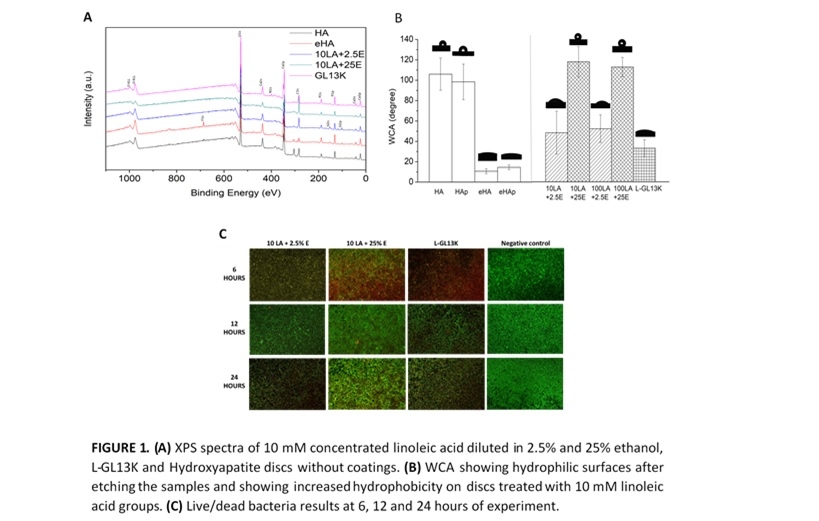IADR Abstract Archives
Antimicrobial and Hydrophobic Properties of Linoleic Acid Coatings on Hydroxyapatite
Objectives: Induced by bacterial leakage, secondary caries is the most prevalent issue affecting longevity of composite resin restorations. New antimicrobial biomaterials have been devised to avoid secondary caries, but most of them are not cost-effective. Since linoleic acid had shown strong antimicrobial properties, we aimed to evaluate colonization inhibition of Streptococcus gordonii (S. gordonii) and Streptococcus mutans (S. mutans) biofilms by a coating with linoleic acid on hydroxyapatite discs.
Methods: Hydroxyapatite discs were coated for 60 seconds using 10 mM concentrated linoleic acid in 2.5% and 25% ethanol solutions, or 1 mM L-GL13K antimicrobial peptide as a positive antimicrobial control. Samples without coatings were used as negative control. Resulting coatings were characterized by X-ray photoelectron spectroscopy (XPS) and water contact angle (WCA) measurements after receiving surface treatments. Visualization and quantification of live/dead stained bacteria and colony-forming unit (CFU) were used to study primary (S. gordonii) and late colonizer (S. mutans) bacterial attachment to the discs, with and without coating.
Results: XPS results showed an effective coating for all the groups (Figure 1A). Treatment with linoleic acid increased surface hydrophobicity (Figure 1B). Discs treated with linoleic acid and L-GL13K had a reduction in microbial viability and biofilm adhesion compared with the non-coated negative control (Figure 1C).
Conclusions: Coating hydroxyapatite discs with linoleic acid had an antibiofilm effect, inhibiting primary and secondary bacterial colonization by S. gordonii and S. mutans, respectively. These findings support further in vivo and clinical studies using linoleic acid as a potent antimicrobial agent.
Methods: Hydroxyapatite discs were coated for 60 seconds using 10 mM concentrated linoleic acid in 2.5% and 25% ethanol solutions, or 1 mM L-GL13K antimicrobial peptide as a positive antimicrobial control. Samples without coatings were used as negative control. Resulting coatings were characterized by X-ray photoelectron spectroscopy (XPS) and water contact angle (WCA) measurements after receiving surface treatments. Visualization and quantification of live/dead stained bacteria and colony-forming unit (CFU) were used to study primary (S. gordonii) and late colonizer (S. mutans) bacterial attachment to the discs, with and without coating.
Results: XPS results showed an effective coating for all the groups (Figure 1A). Treatment with linoleic acid increased surface hydrophobicity (Figure 1B). Discs treated with linoleic acid and L-GL13K had a reduction in microbial viability and biofilm adhesion compared with the non-coated negative control (Figure 1C).
Conclusions: Coating hydroxyapatite discs with linoleic acid had an antibiofilm effect, inhibiting primary and secondary bacterial colonization by S. gordonii and S. mutans, respectively. These findings support further in vivo and clinical studies using linoleic acid as a potent antimicrobial agent.

